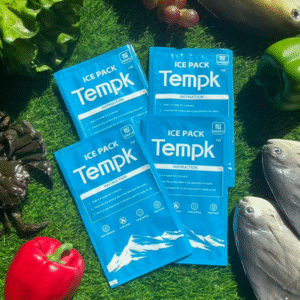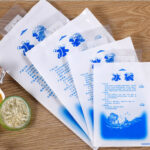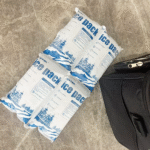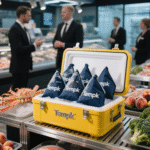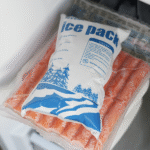Trockeneisbeutel für Insulin: How to Keep It Safe
A Trockeneisbeutel für Insulin can protect potency on long, hot routes—nur if you buffer vials from freezing and vent CO₂. Insulin should stay 2–8 ° C in storage and must niemals be frozen. Airlines typically cap dry ice at 2.5 kg (5.5 lb) pro Passagier, so sizing and labeling matter. Below you’ll get a simple layering method, quick sizing rules, and a traveler checklist designed for 2025. This synthesis merges and improves three Tempk drafts updated Sept 22, 2025.
-
Decide when to use a dry ice pack for insulin on routes over 36–72 h (long-tail: how to keep insulin cold while traveling).
-
Build a freeze-safe 2–8 °C pack-out mit a +5 °C phase-change buffer (long-tail: insulin temperature control 2–8°C).
-
Fly within 2025 airline rules using clear labels, Lüftungsschlitze, und Dokumentation (long-tail: airline rules dry ice medical).
-
Right-size PCM and dry ice loads with simple rules of thumb (long-tail: PCM cold packs for medications).
When should you use a dry ice pack for insulin?
Use a dry ice pack for insulin only for multi-day or high-heat itineraries, and always insert a +5 °C PCM layer between insulin and dry ice. For trips under ~24–36 hours, PCM or conditioned gel packs are simpler and avoid dry-ice paperwork. Dry ice is −78.5 °C; without a buffer, insulin can freeze in minutes and must be discarded.
Warum das für Sie wichtig ist: Think of the pack-out as a thermal sandwich: insulin in a rigid inner case → +5 °C PCM bricks → insulation → dry ice in the outer cavity with vents. That structure “throttles” extreme cold into a safe 2–8 °C zone while venting CO₂. Choose dry ice for ≥36–72 h hold or routes ≥32–35 °C. Ansonsten, go PCM-only to reduce weight and compliance steps.
How does a dry ice pack for insulin avoid freezing?
Keep at least 1–2 cm of +5 °C PCM between insulin and any dry ice, and never seal the outer container airtight. Place a data logger inside the insulin cavity, not near the dry ice. Set alarms at 2 °C low and 8 °C high with a 10–15-minute delay to ignore brief openings.
| Layered Pack-Out | Beste Practice | Common Mistake | What It Means to You |
|---|---|---|---|
| Inner container | Rigid pen/vial case | Soft pouch only | Prevents crush and pressure damage |
| Thermal buffer | +5 °C PCM bricks (≥1–2 cm) | Gel packs used straight from freezer | Holds 2–8 °C; blocks sub-zero contact |
| Isolierung | EPS/EPP or VIP panels | Thin lunch-bag foam | Verlängert die Haltezeit, reduces dry ice needed |
| Kältemittel | Trockeneis draußen PCM layer | Dry ice touching insulin cavity | Long hold without freeze risk |
| Entlüftung & Etiketten | Lüfter Deckel + weight marked | Airtight seal, no net weight | Compliance and safety in flight |
Practical tips you can use now
-
Short trip (≤18 h, ≤25 °C): Use PCM-only; skip dry ice to cut weight and rules.
-
Warm trip (18–36 h, 25–32 °C): Add insulation or extra PCM; still avoid dry ice if possible.
-
Hot or multi-day (≥36 h or ≥32 °C): Use a dry ice pack for insulin with PCM buffering, Lüftungsschlitze, und Etiketten.
-
Einmal testen: Do a 12–24 h trial with a logger before your real trip.
Wirklicher Fall: A 52-hour door-to-door itinerary kept three pens at 3.2–7.6 °C using a rigid inner case, two +5 °C PCM bricks, Und 0.6 kg dry ice in a vented outer tote—no freeze alarms recorded.
How do you pack insulin with a dry ice pack for insulin safely?
Core build (≈10 minutes): Pre-chill PCM to 2–8 °C → stage insulin in a small rigid case → wrap with +5 °C PCM on 4–6 sides → add insulation → place dry ice draußen the PCM layer → keep the outer box vented and labeled with net weight.
Sizing rules that actually work (quick math)
Rule A (by ambient):
-
Mild (≤25 °C): PCM-only.
-
Warm (25–32 °C): 0.25–0.5 kg dry ice/day, with PCM buffer.
-
Heiß (≥32 °C): 0.5–0.8 kg dry ice/day, with PCM buffer.
Rule B (by payload/time, Für den Versand): In der Nähe beginnen 50% of total payload weight in dry ice for ~48 h, then adjust ±10% for climate and duration—still keep insulin isolated behind +5 °C PCM. Use bricks for slower sublimation; pellets for short lab hops only.
Entscheidungshelfer: do you need a dry ice pack for insulin?
-
Total hours door-to-door?
-
Peak Umgebung (°C)?
-
Pens/vials count?
-
Will you be separated from refrigeration?
-
Airline segment with approvals in hand?
If ≥36 h or ≥32 °C: choose a Trockeneisbeutel für Insulin mit ≥4 +5 °C PCM bricks Und 0.5–0.8 kg/day dry ice in a entlüftet outer container. Ansonsten, PCM-only is lighter and simpler.
Do airline rules limit a dry ice pack for insulin in 2025?
Ja. Die meisten Fluggesellschaften erlauben bis zu 2.5 kg (5.5 lb) of dry ice per passenger/package for medical perishables. Pakete müssen CO₂ Wind, and checked baggage needs “DRY ICE / CARBON DIOXIDE, SOLID” Plus die Nettogewicht on the label. Bring prescriptions and declare medical cooling accessories at screening; medical gel/PCM packs are permitted in carry-on. Some carriers require pre-approval—call ahead.
Traveler cheat-sheet (do this): Pre-weigh and label the dry ice; keep the lid undicht; pack documentation and your logger. For Alaska, island, or long connections, carry a spare PCM pouch in your personal item in case dry ice is refused on a segment.
Dry ice pack for insulin vs. gel/PCM packs: which wins?
For most trips, +5 °C PCM wins because it naturally guards 2–8 °C with fewer rules. Pick a dry ice pack for insulin when heat and duration exceed PCM alone, or access to refrigeration is uncertain for days. Reusable PCM kits cut weight, Abfall, and uncertainty for typical 24–36 h travel.
2025 Entwicklungen: where a dry ice pack for insulin fits
Was ist neu in 2025: Airlines continue to emphasize declared Netto -Trockeneisgewicht Bei der Buchung. Health programs promote electronic temperature monitors for traceable records. Consumer-grade +5 °C PCM kits add clear thaw indicators to reduce misuse. Standards like ISO 21973 still reward documented, data-logged pack-outs—great for speeding security checks.
Neueste Fortschritte auf einen Blick
-
Smarter loggers: Low-cost Bluetooth units make shareable PDF reports routine.
-
Better PCM kits: +5 °C bricks and wraps extend hold with less mass.
-
Clearer airline pages: Many carriers plainly restate the 2.5 kg dry-ice limit and marking rules.
Market insight: Travelers and small clinics favor reusable PCM sets und fügen Sie hinzu small dry-ice layers only for ultra-hot or multi-day legs. This cuts waste and simplifies compliance while keeping insulin within 2–8 °C.
FAQ: your dry ice pack for insulin questions
Can I put insulin directly against a dry ice pack?
NEIN. Dry ice is −78.5 °C. Always isolate insulin with +5 °C PCM or conditioned packs plus spacers.
How much dry ice can I bring on a plane?
Typischerweise 2.5 kg (5.5 lb) per passenger with vents and labels; some airlines require pre-approval—confirm before flying.
Do I need dry ice for a 12-hour flight?
Normalerweise NEIN. A small +5 °C PCM kit in a rigid pouch is enough when kept out of sun and checked with a mini logger.
What if insulin froze?
Discard it. Freezing damages proteins. If unsure, treat as compromised and consult your pharmacist.
Where do I place the temperature logger?
Inside the insulin compartment (the 2–8 °C zone), not near the dry ice. Export the report after arrival.
Zusammenfassung & recommendations for your dry ice pack for insulin
Schlüsselpunkte: Buffer insulin with +5 °C PCM, halten Lüftungsschlitze open, Etikett Netto -Trockeneisgewicht, Und Protokoll Temperaturen. Choose PCM-only for ≤24–36 h. Verwenden Sie a Trockeneisbeutel für Insulin only for multi-day or high-heat routes. Never use insulin that has frozen or shows clumps/crystals.
Nächste Schritte (CTA):
-
Map your route hours and peak ambient. 2) Wählen PCM-only oder buffered dry ice using the sizing rules above. 3) Run a 12–24 h trial with a logger. 4) Print labels, weigh dry ice, and pack your documentation. Brauche Hilfe? Book a 15-minute pack-out review with Tempk.
Über Tempk
We design practical cold-chain solutions for patients, Kliniken, and field teams. Unser +5 °C PCM kits Und freeze-preventive carriers are built around data logging and airline compliance. We focus on lighter builds, clear checklists, and repeatable results so you can travel confidently with less guesswork.






